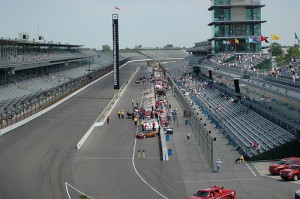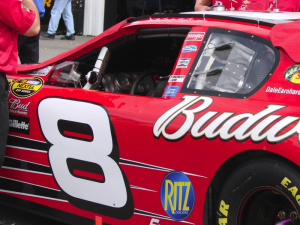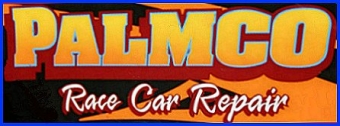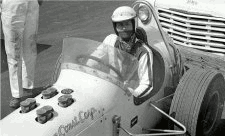Archive for Opinion
Indy 500: 1984 vs. 2009
Posted by: | CommentsI enjoy watching Dave Despain's Sunday night TV show Wind Tunnel on SPEED TV. I've been a fan of Despain ever since the good-ol' days of Saturday Night Thunder over on "the other network".
With Indy 500 qualifying just a month away, Robin Miller was on the show to help alleviate fears that we won't see a full field of cars to celebrate the 100th Anniversary of the Indianapolis Motor Speedway this May. Miller proposed a variety of car and driver combinations that are likely to fall into place in time for qualifying. As I listened attentively, I was reminded of just how much it tears into my heart that year after year in recent memory they've had to piece together a driver field for "The Greatest Spectacle in Racing".
I remember a time when Indianapolis 500 Pole Day Qualifying drew the second-largest crowd in the US for a sporting event, second only to the race itself of course. These days there isn't a crowd to even speak of. Once televised on ABC and ESPN, pole qualifying has shifted to the Versus network this year. And although the race remains a sell-out -- or near sell-out -- television ratings have slid markedly over the past decade. There's no way to whitewash it: interest in "The 500" has clearly waned.
And what to make of it?

Indy 500 Qualifications: Not much interest these days.
(Photo by cmakin from flickr.com / CC 2.0. May 19, 2007)
I decided to take a step back 25 years and scan over the starting lineup for the 1984 "500". What becomes immediately evident is the number of "household names" in the field that year. Names that I think any non-racing fan would easily identify with Indianapolis: Foyt, Unser, Andretti, Mears, Rutherford. Broaden it out to "casual sports fan" and many more names are familiar: Sneva, Johncock, Rahal, Sullivan. Draw in the average race fan and names like Bettenhausen, Ongais and Pancho Carter surface.
Should we compare that field with what's expected in 2009? Who would be the "household names"? The names of drivers we'd get if we randomly asked people on the street, "Who drives at Indianapolis?" Well we might get Danica Patrick, thanks to GoDaddy.com's heavy promotion and, well, obvious other reasons. They would probably identify with Graham Rahal and Marco Andretti because of the last names, but wouldn't know a thing about them. But other than that, I can't think of any other drivers that permeate the American psyche. And even when you get down to the average racing fan, you don't come up with much more. Race fans will know Dan Wheldon and Dario Franchitti and Scott Dixon most likely. However, our 2009 field is likely to contain Mike Conway, Mario Moraes, Robert Doornbos, Raphael Matos and the like. I'm sure these are great people and good drivers... but what can I say? I have absolutely no idea who they are or what they've accomplished in racing. And I'm inclined to believe that I'm not the odd man out. Why do they bring so little fan following? Probably because they cut their teeth in the forms of racing that generate virtually no fan interest in America.
So here it is: Somewhere along the line, somehow, "Indy" cars turned into "Formula" cars. That's what they race now. They can call it whatever they want, but they're formula cars -- expensive and designed for road racing, not oval racing. The driving styles of America's short-track racers -- you know, the guys who actually have fan followings in this country because people watch them week in and week out -- are totally incompatible with road racing formula cars. So "drivers" like Milka Duno from God-knows-where buy rides into the most prestigious race in world history while racers like Chad Boat and Jerry Coons, Jr. watch on TV. And the result? Nobody cares. It really is that simple.
Reds and Blacks
Posted by: | CommentsI grabbed a cold drink and some chips Sunday and sat down to watch the IndyCar opener from Florida. I figure it's a new year, things have changed... I'll give it a try and see what to expect in 2009. I mean... how bad could things be?
It's bad.
Real bad.
Worse than a Robin Miller column.
The first thing I noticed is that the starting lineup only sported twenty-two drivers. Twenty-two! After all the hype about how reunification was going to save the IndyCar world and increase field sizes and all that, they came up with 22 starters -- for the season-opener. Not to mention, I didn't even recognize an easy third of the drivers starting, and I sometimes fancy myself as being a reasonably interested fan of auto racing.
After the race started and the field bombed into the obligatory turn 1, lap 1 crash to bring out a full-course yellow I noticed the next travesty: of all the amazing, first-class racing facilities that are readily available in this great country, they decided to throw some temporary barriers up on the public roads of St. Petersburg to race on a narrow, single-lane street course with virtually no passing opportunities. Ummm... why?
But the thing that most intrigued me was the new tire gimmick. For 2009, Firestone will be bringing two tire compounds to the street and road races. A softer compound -- called "reds" since they're identifiable by a red sidewall -- to provide extra grip, and the traditional black slick tires that have the durability. Well, okay... having a couple of tire options for the teams isn't such a bad idea I guess. But then the sanctioning body decided to get in on the idea by writing a new rule requiring each team to run at least two green flag laps on the "red" tires.
And so there it is... now they have a new "element" to add to the racing story and something for the television folks to talk about. Because heaven knows there's nothing going on on the race track to talk about. Now we have to keep track of who's on what tires. So Firestone brought a soft tire for better passing to a street course... where there's no passing? Holy smokes -- I haven't seen this much of a circus since A.J. Foyt slapped Arie Luyendyk in Victory Lane at Texas.
Tony George... what happened, man?
Here's the deal: IndyCar racing has turned into a "club sport". It has virtually no fan appeal and has essentially become irrelevant in the American motorsports psyche. Take out the 500 and it is irrelevant. Broaden the audience to the "casual sports fan" and nobody has a damn clue who those guys are racing out there.
Sometimes I get crazy ideas, so here's one to share: How about concentrating on building fan interest by racing real cars on real race tracks with drivers that race fans know and can connect with? And maybe leave the gimmicks to... oh I dunno... Monster Truck racing.
(PS: I was just kidding about the Robin Miller thing... Come on -- who doesn't love Robin Miller?)
Under Pressure
Posted by: | CommentsFans of Dale Earnhardt, Jr. have to be disappointed with how the 2009 season has started. After five races, the point standings show that he's mired back in 19th position. He's only posted one top-ten and, worse yet, has led only a single lap. A handful of driving mistakes at Daytona and a blown engine at Fontana, CA have set the tone for the early part of the season.
One could imagine the pressure that Earnhardt, Jr. must be experiencing. His move in 2008 to Hendrick Motorsports was supposed to be the key that opened the door to winning championships and lifting his career to heights worthy of the Earnhardt name. Many thought the move was a good one; even Darrell Waltrip was predicting a handful of wins in his first year with Hendrick. And the 2008 season started off well -- a victory in the Bud Shootout all-star event followed by another win in the Gatorade 150 Daytona qualifying race. But things quickly turned flat for the team and they eventually fell out of contention for the championship, posting only a single race win on a fuel-mileage run at Michigan.

In 2007, Dale Earnhardt, Jr. suprised the NASCAR world by announcing that he would leave the team his father created and race for Rick Hendrick in 2008.
At 34 years old, Dale Jr. knows that if he wants to be one of NASCAR's all-time greats like his father, the time to win championships is now. With 18 career Cup wins, Dale Jr. is no slouch behind the wheel, of course. But at the same time it's easy to expect that he'll be judged against his father's success. Much of what he enjoys now -- the merchandise sales, NASCAR's Most Popular Driver year after year, etc. -- is best attributed to the Earnhardt name.
In fairness, from the very beginning Dale Jr. has insisted that he is his own person with his own driving style. I think it's important for us fans to respect that. Some critics might argue that he doesn't have the drive and determination that his father did. But in some ways that's unfair: his father raced at a time when he had to make his own name and his own financial success on the racetrack. Fame and fortune can be an incredible motivator and, let's face it, Dale Jr. has those things already.
It's hard to see what changes Dale Jr. would have to make to win a championship. Clearly Hendrick Motorsports is a top NASCAR enterprise, but it's not so clear that Dale Jr. has the best equipment on the circuit. He insists on keeping crew chief Tony Eury, Jr. on board, but a different crew chief might go a long way. Would Jimmie Johnson be so successful without Chad Knauss? How about Jeff Gordon's early years without Ray Evernham?
And what about Kyle Busch? When driving this very same car for Hendrick he had only modest success. Now that he's in the Gibbs organization he's winning everything in sight.
So was the move to Hendrick Motorsports a good one for Dale Jr.? Time will tell. He started his career at Dale Earnhardt, Inc. and posted two wins in his rookie season in 2000. His most successful year was 2004, when he won six times, including the Daytona 500. He was right there amongst the point leaders, but his run for the championship ended against the backstretch wall at Atlanta. Then things went downhill. One win each in 2005 and 2006, and no wins in 2007, when he finally pulled the trigger and announced he would leave DEI for Hendrick Motorsports.
I like Dale Jr. He drives cleaner than his father but still has some of that throwback to old-school racing. He's not as polished as many of the newer drivers and isn't a crybaby whiner like some of the others. I think if the right opportunity comes along and he gets solid equipment he should be able to snag one or two of those Cup trophies after all.
As for 2009, the next several races could present the best opportunity to turn the season around as the team goes to tracks where Dale Jr. does well at. He has one career Cup win at Texas, two at Phoenix, five at Talladega and three at Richmond.
Ratings Slide Continues
Posted by: | CommentsWell here's one you can't blame on the bad economy: overnight ratings for Sunday's Bristol race are down 18% from last year. Not too surprising, as the trend for the year has averaged down 11% already. And ratings have been petering out the past few seasons.
There are some obvious reasons for the decline, the clearest one being "the product" itself. NASCAR racing has become incredibly dull. And I'm not so much referring just to what's happening (or not happening) on the track -- there have always been boring races, and every sport has boring games. The problem as I see it is that there is no "off-track drama" to sustain people's interests. That is, the sport itself isn't exciting. The drivers are boring. There are no controversies or rivalries. The cars are embarrassingly ugly. The tracks are mostly the same configuration and the ones that are different are paved like sidewalks. Hell, I don't even admit liking NASCAR to my friends anymore -- I tell them I watch cricket.
But let's look past those obvious things and admit that NASCAR has another problem: the television coverage is absolutely terrible. And it seems to be across all networks. Between screaming rodents, quacking ducks and "boogity! boogity! boogity!", they have helped take NASCAR from a man's sport to a silly 3-hour joke more fitting of an afternoon at Sesame Place. Seemingly gone are the days of gritty drivers piloting bad-ass cars on a razor's edge and even breaking a sweat while doing it. If us fans are looking to watch cartoons and comedy, there are plenty of better options on the television dial that we can choose from.
It is really at the point now where I find it painful -- yes, painful -- to watch a NASCAR race on television. Certainly it is true that they have many more cameras than in the old days, and a lot more of the action is caught because of that, but the overall experience portrays "the product" as a kiddie sport no more dangerous than whiffle ball.
Unless NASCAR wants to "realign" itself right into irrelevance, it needs to pick up the phone here and address the state of its television coverage. It negotiated these big TV packages to begin with, I'm sure they could make changes happen... if they wanted to.
I Could Do Without This Guy
Posted by: | CommentsSometimes I ask myself if all the disdain for Kyle Busch is really justified. Then he'll go out and do something so childish and embarrassing that my doubts are kept in check. Saturday was one of those days when he reminds the racing world that he is the most classless driver on the circuit.
After dominating the Nationwide race at Bristol, one of his crew members made a mistake on the final pitstop by allowing the right-rear tire to roll outside of his pit box. Busch picked up the standard NASCAR penalty of restarting at the end of the lead lap line, which in this case was 14th position. He ended up finishing sixth.
Okay, we get it: the guy made a mistake and it probably cost them the race. Everyone has a right to be passionate about it. But where Kyle loses points is in his childish antics. After learning about the penalty he ripped his team through the in-car radio. Then, after the race was over, he didn't even bother driving the car back to the garage area. He parked it on the track, threw off his helmet to show his anger and left the facility -- clearly an insult to his team.
The reality is that NASCAR is a team sport. You win as a team, and you lose as a team. It's always been that way, and always will be that way. Kyle Busch is not a team player; probably because he feels that his talent is above his crew's abilities. Some day he is going to make a mistake when driving the race car. What would he think if his crew threw up their hands, told him he sucks, and then refused to service his car for the rest of the day?
Here is where the problem lies: the racing media has launched this guy into God's gift to the racing world and have fed his relentlessly immature self-aggrandizing by endlessly talking up his perceived greatness. Then all the Busch apologists come out to defend him on TV when he acts like a spoiled brat. Even this evening Jimmy Spencer and Kenny Wallace used their platform on SPEED TV to speak of Busch's "righteous anger" when dealing with his crew. Wallace offered that Busch's greatness makes him "the Dale Earnhardt of now". (With all due respect, I do not believe that Kyle could carry Earnhardt's jock strap.)
Busch will probably go on to have a lot of victories, but if he doesn't grow up quick, he'll never be one of NASCAR's greatest drivers. NASCAR's greatest drivers were also some of the best people. Ned Jarrett, Neil Bonnett, Bobby Allison, Richard Petty -- all drivers with talent, passion, and success in their own right -- but also good gentlemen that have represented the sport well.
Here is one fact I know about automobile racing: there is no other sport in America that can humble a man in the wink of an eye like this sport can. One moment you can be the hottest driver on the circuit, and the next moment you're laid up in a hospital. If Busch is building his personality on victories and brash ego alone, he is opening himself up to the possibility of a huge downfall.
Who knows... maybe that Formula One ride will come through after all. That'll be just one less punk NASCAR fans will have to deal with.
Manzanita Speedway Petition
Posted by: | CommentsThe announcement that Manzanita Speedway has been sold and is closing in mid-April was a surprise to many of us. The track has been purchased by Southwest Rigging, which plans to level the track. There's a petition at www.savethetracks.com that aims to prevent its demise. Check out the site for more information. Then, click over to the petition and sign it when you get the chance. (Hat-tip to Ken for the heads-up.)
I've never been to Manzy myself, but being from New Jersey I'm familiar with tracks closing down. I remember watching sprint races at Manzanita on TNN during the winter time in the '90s.
It's hard to imagine that they're going to bulldoze a historic track just to use the land to store crane equipment. One would think that with all the land readily available in Arizona, there has to be a better site for crane storage.
According to The Arizona Republic, it sounds like the track has succumbed to what has become a common thread in short-track racing: lagging attendance and noise complaints of an encroaching residential population. Nevertheless, it seems the owners will be raking in a substantial profit from the sale.
Southwest Industrial Rigging purchased Manzanita from co-owner Mel and son Bobby Martin for an amount the younger Martin said was between "$10 (million) and $20 million." The Martins bought the track, which encompasses 38 acres on the southeast corner of 35th Avenue and Broadway Road, in August 2007 for $3.5 million.
"I haven't slept two hours a night since we agreed to sell two weeks ago," said Bobby Martin, who is 59. "I was 2 years old when I first came to Manzanita. My dad helped build the track (in 1951). I own race cars, and we've spent $1 million for renovations.
"I thought we'd get 10 years out of it before we'd have to sell it. But attendance is down 40 percent, and we lost ($468,465) last year.
"We still had enough money to last several years. It's just that the nail in the coffin was some environmental issues involving dust and also noise complaints from neighbors. We knew eventually we'd get closed down because of it."
Bobby Martin said fans have been understandably upset with the news.
"A lot of people have called us and expressed their dissatisfaction," Martin said. "Everybody feels like we didn't give racing people a chance to buy it, but I didn't know anyone out there with that kind of money. And even if there might have been, you still had the environmental issues. The county had two pages of complaints against us."
My suspicion is that it had more to do with the money than the "environmental issues," but we may never know. Either way, it'd be a shame if the track is closed.
NASCAR Without Chevy?
Posted by: | CommentsAs hard as it is to believe, before the end of the Sprint Cup season the "Heartbeat of America" may be flat-lined for good. News that GM's auditors have "substantial doubts" that the company can avoid bankruptcy have resurfaced fears that 2009 might be a very difficult year for motorsports. Complicating matters is the increased government oversight of the auto manufacturers in response to the loans they received to continue operations. It'll be increasingly difficult to justify spending "bailout" money on racing programs, even if they genuinely do represent dollars spent on effective advertising.
Of course a NASCAR without Chevy is like corn flakes without milk; nevertheless, NASCAR racing could probably absorb the shock of losing Chevrolet. But if Dodge and Ford were quick to follow, the circuit would likely be drastically affected. I'm sure there would be plenty of available equipment to go around... at first. The lack of corporate financing would hurt the smaller teams most. Big teams like Hendrick Motorsports, who do their engine work in-house, would probably make it through the season relatively unscathed. But teams who purchase engines from Hendrick, et al, might not be in such a favorable position.
The big question mark surrounds short-track racing. Chevrolet provides the bulk of the engines at local short tracks and it's unlikely that another manufacturer -- especially a foreign one -- could step in quickly enough to meet the demand. And call me Captain Obvious but... it's hard to enjoy motorsports without motors.
General Motors has supported our sport for a long time. Just 20 years ago they fielded four different models in the NASCAR Cup Series. Chevrolet was there when Dale Earnhardt finally won the Daytona 500 in 1998, and that same year saw Jeff Gordon to an incredible 13 wins. Not to mention seven victories in the Indianapolis 500.
Hopefully they can pull through this and get back on their feet.

